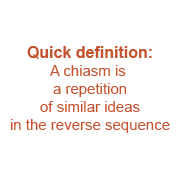What's a Chiasm?
An Unusual Literary Style in the Bible
A chiasm (or chiasmus if you rather) is a writing style that uses a unique repetition pattern for clarification and emphasis. Chiasm is pronounced ky′-az-um.
Often called the chiastic (ky′-az-tic) approach or the chiastic structure,
this repetition form appears throughout the Bible yet it is not well known.
The way you approach the scriptures should be dramatically enhanced as you learn what a chiasm is, how to recognize chiasms, and how to glean a fresh application
from these New or Old Testament passages.
Chiasms are structured in a repeating A-B-C ... C′-B′-A′ pattern:
| A | Just as I have been with Moses, I will be with you; I will not fail you or forsake you. (v5B) | |||
| B | Be strong and courageous, for you shall give this people possession of the land which I swore to their fathers to give them. Only be strong and very courageous; (v6,7A) | |||
| C | Be careful to do according to all the law which Moses My servant commanded you; do not turn from it to the right or to the left, so that you may have success wherever you go. (v7B) | |||
| D | This book of the law shall not depart from your mouth, (v8A) | |||
| D′ | But you shall meditate on it day and night, (v8B) | |||
| C′ | So that you may be careful to do according to all that is written in it; for then you will make your way prosperous, and then you will have success. (v8C) | |||
| B′ | Have I not commanded you? Be strong and courageous! Do not tremble or be dismayed, (v9A) | |||
| A′ | For the Lord your God is with you wherever you go. (v9B) | |||
| (Joshua 1:5B-9, NASB 95) | ||||
Simply put, a chiasm is a repetition of similar ideas in the reverse sequence. The importance of the chiastic structure is found in its hidden emphasis and its clarification of context. (See Being an Overcomer for an interpretation of the above chiasm, adapted from my book). And it is not insignificant – having now sampled at least 25% of every book (my analysis has studied all of the New Testament, the minor prophets, and half of the remainder), there are well over one thousand examples in the Bible!

My time in God's Word has become truly exciting as I have learned to uncover the chiastic structures.
Over the years, I have studied the Scriptures from many different angles – for me, seeing God's Word from the chiastic perspective has added a great deal of meaning.
Yet today, many who have read the Bible are just beginning to discover this even though it was identified over two hundred years ago (see Background of Chiasms).
A chiasm organizes themes much like a sandwich:
A) a piece of bread on top, B) mustard, C) a delightful piece of meat, C′) another savory piece of meat, B′) more mustard, and finally A′) another piece of bread on the bottom.
Chiasms generally focus on the flavorful meat – the bread is often important as well.
Some chiasms do not have a mustard layer, other chiasms have lettuce on both sides of the meat, and some have just one piece of delicious meat.
The mustard, lettuce and other vegetables are part of the complete sandwich.
When the Holy Spirit inspired the Hebrew and Greek writers to inscribe their portions of the Scriptures, the chiastic structure was often used to add emphasis.
He could not use techniques such as bold, italics,
underline, indentation, bullets, or to help the reader understand what is important
because these were not part of the ancient languages at the time.
Instead He often used the structural arrangement of repeated thoughts or phrases to accomplish this emphasis.
The Holy Spirit also used chiasms for the sake of clarification. Sometimes in the Bible, a particular verse can be taken several different ways. Is it lettuce, arugala, endives or kale? By looking at its pair, the name of the vegetable may be stated. That troublesome metaphor is now clarified. Recognition of the chiastic structure can help better understand the passage.